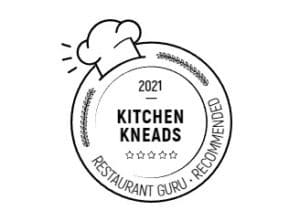Garlic Herb No Knead Bread is on the menu today. I have to say that I’ve never made a no knead bread before because I looked at it as cheating. I know how to make kneaded bread and I have a mixer to do that work for me, so why would I need to stoop to a no knead bread? I started getting curious, though. Then I saw a recipe that sounded really good, so I tried it. Let me tell you, I’m so glad I did!
Contrary to my former belief, no knead breads are NOT cheating because there’s more than one way to develop gluten. One is, obviously, by kneading. Another way is by not kneading. Let me explain: If you have a dough that’s wet enough, as it sits for 12-18 hours, the glutenin and gliadin move around and form gluten on their own. The dough does need to be wet enough, though, and it works best with a lean dough. A lean dough is one without fat and other extras. Pretty much just flour, salt, yeast, and water. Below is a picture of some no knead dough that had been sitting for a couple of hours. You can see how wet it is.
The result is a crusty, chewy, dense bread. I haven’t been this excited about a loaf of bread in years. I’m seriously so happy about this. Imagine the possibilities! Because kneading is not required, it’s a perfect solution for baking bread in an emergency situation where you don’t have electricity to power a mixer. Just pop it in a dutch oven to bake over some coals. My husband and I are planning on taking this recipe camping with us this summer. Wouldn’t it be fun to mix up a batch of dough in the morning, let it sit all day, throw it in a dutch oven that evening and have some fresh baked bread with dinner? I think so!
It’s also a great solution for those who can’t make the investment in a mixer yet. Or if you’re like me and you have a mixer and can consistently produce great loaves of bread, it’s still a fun way to easily make a different style of bread with a different (and amazing) texture. So I hope you give this recipe a try! I’m sure you’ll be glad you did.
[yumprint-recipe id=’185′]
















Leave a Reply